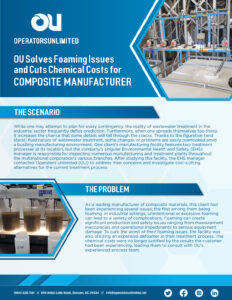OU Solves Foaming Issues and Cuts Chemical Costs For Composite Manufacturer
The Scenario
While one may attempt to plan for every contingency, the reality of wastewater treatment in the industrial sector frequently defies prediction. Furthermore, when one spreads themselves too thinly, it increases the chance that some detail will fall through the cracks. Thanks to the figurative (and literal) fluid nature of wastewater treatment, some changes or problems are easily overlooked amid a bustling manufacturing environment. One client’s manufacturing facility features two treatment processes at its location, but the company’s singular Environmental Health and Safety (EHS) manager is responsible for inspecting numerous manufacturing and treatment plants throughout the multinational corporation’s various branches. After studying this facility, the EHS manager contacted Operators Unlimited (OU) to address their concerns and investigate cost-cutting alternatives for the current treatment process.
The Problem
As a leading manufacturer of composite materials, this client had been experiencing several issues; the first among them being foaming. In industrial settings, unintentional or excessive foaming can lead to a variety of complications. Foaming can create significant production and safety issues ranging from measurement inaccuracies and operational impediments to serious equipment damage. In an attempt to curb the worst of their foaming issues, the facility was also utilizing an expensive defoamer in their treatment process. The chemical costs were no longer justified by the results the customer had been experiencing, leading them to consult with OU’s experienced process team.
The Solution
OU engineers conducted extensive jar testing to gain a comprehensive understanding of the facility’s chemical profile. While often viewed as tedious or time-consuming, OU’s team believed jar testing would better serve the customer in the long term. By diving into jar testing reports, OU was able to demonstrate a multitude of ways in which their customer could achieve desired results while cutting overall costs. Their preferred coagulant, ferric chloride, is commonly seen throughout the wastewater treatment industry despite its propensity for staining.
Testing revealed that the ferric chloride had been used in extreme excess when only one-fifth of the same chemical would achieve the desired results. What’s more, the OU team found a cheaper alternative coagulant that was much less difficult to handle. Naturally, the excessive coagulants had also yielded excessive solids thus incurring higher disposal costs.
Thanks to the team’s experience and attention to detail, OU’s in-depth analysis led to significant cost reductions on several fronts for the client. Chemical costs were reduced by approximately one fifth and the cost of solids disposal (and associated labor costs) was reduced by one-third.
By identifying the problems inherent in their previous chemical regimen and identifying appropriate alternatives, OU’s thorough approach made an undeniable impact on the facility’s bottom line. The new chemistry rectified previous foaming issues the facility had been experiencing, compounding their savings by eliminating most of the costly defoamer that had previously been essential.
The Results
- The new chemical that OU introduced to the facility reduced the time required to treat the facility’s wastewater fully.
- The new coagulant’s weight facilitates faster separation during the settling phase which constitutes one half of the treatment process.
- The hastened settling contributed to further savings by decreasing operational labor costs.
Once separated, the solids are transferred to a filter press while liquids are transferred to the treatment process’s secondary phase. There, wastewater is introduced to a clarifier for further separation. Because the waste stream contains high levels of ammonia, some is redirected to a closed biological processing tank.
While the facility had not been in danger of non-compliance, its operators and managers chose to take a proactive and preventative approach to addressing wider treatment concerns. Operators Unlimited offered a time and cost-efficient solution at this facility with a net savings of $6,000+ within a 4-month timeframe.







